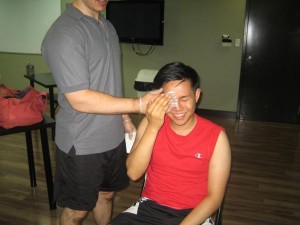A recurrent corneal erosion is described as a persistent breakdown or opening of the cells on the upper layer of the cornea. The cells that comprise the upper layer of the cornea are called as epithelial cells. These cells are tightly bound to the cornea by the layer underneath which is known as Bowman’s layer. This layer functions as an adhesive that holds the epithelial cells closely to the eye.
Once the layer is unhealthy or damaged, the upper layer of the epithelial cells could not properly heal and poorly bind to the Bowman’s layer. As an outcome, the epithelial cells easily come off. The epithelial cells are capable of regeneration but poorly anchored to the Bowman’s layer. Every now and then, the cells fall off easily which leaves an open sore that is similar to a scratch or an eye abrasion.
What are the risk factors?
A persistent corneal erosion is characteristically triggered by an earlier injury to the cornea as well as the Bowman’s layer. If the eye is injured with a pointed object or fingernail which results to a corneal abrasion, the individual is at risk for later on developing recurrent corneal erosion.

Individuals suffering from certain corneal dystrophies, Fuch’s endothelial dystrophy, Reis-Bucklers dystrophy, granular dystrophy and lattice dystrophy can end up with recurrent corneal abrasions. Among these individuals, the front region of the cornea is affected which causes the epithelial cells to poorly bind to the cornea. Oftentimes, they erode spontaneously but those who have anterior basement membrane disease with a scratch in the eye face a higher risk for developing recurrent corneal abrasions later in life.
Those who have dry syndrome also face the risk for recurrent corneal abrasion especially those who had sustained previous eye injuries.
What are the signs and symptoms?
The symptoms are somewhat similar to a corneal abrasion. Individuals with recurrent corneal abrasion usually complain of the following:
- Tearing
- Sharp pain
- Sensitivity to light
- Gritty or sandy sensation in the eye
- Redness
- Tearing
- Blurry vision
- Uncontrollable urge to blink
Management
The treatment for recurrent corneal erosion involves calming the affected eye using cycloplegic eye drops. These eye drops momentarily paralyze the muscle spasm within the eye that is triggering the pain.
Since recurrent erosions are similar to open wounds, they can become infected. Antibiotics might be prescribed if the individual is at risk for developing an infection. In some cases, a bandage contact lens is applied on the cornea for a few days or weeks. It helps keep out foreign substances as well as protecting the cornea from eyelid rubbing against the erosions. The doctor will require follow-up appointments initially to ensure that the erosion is healing and not becoming infected.
